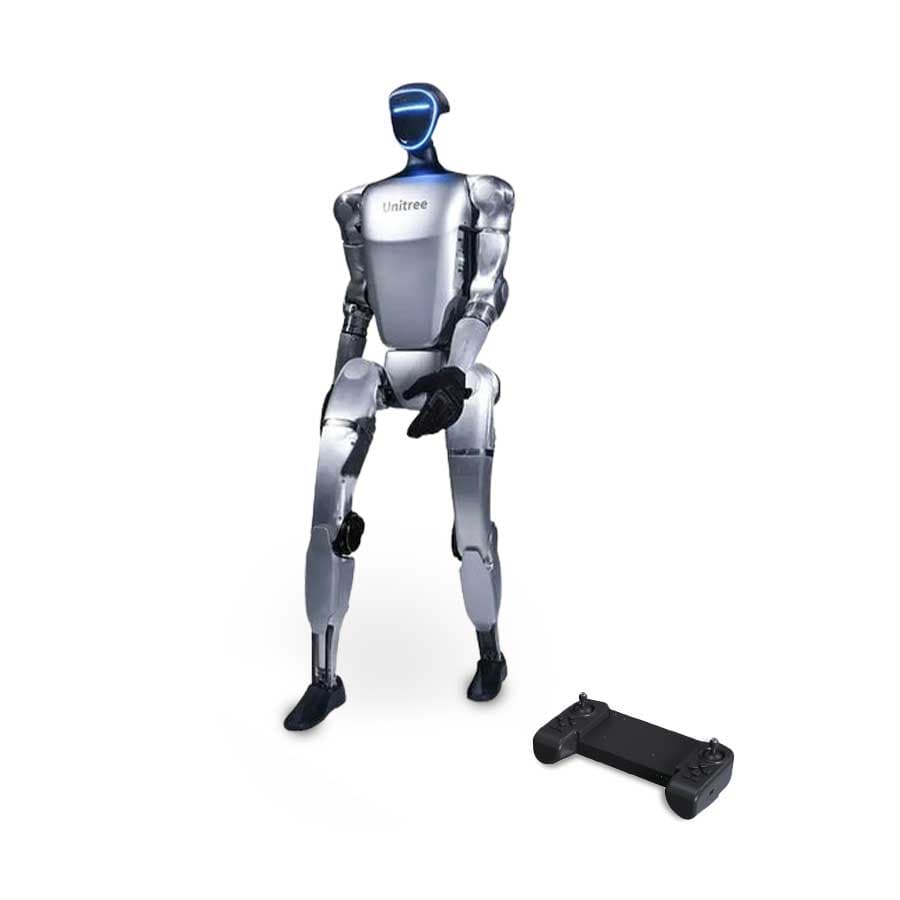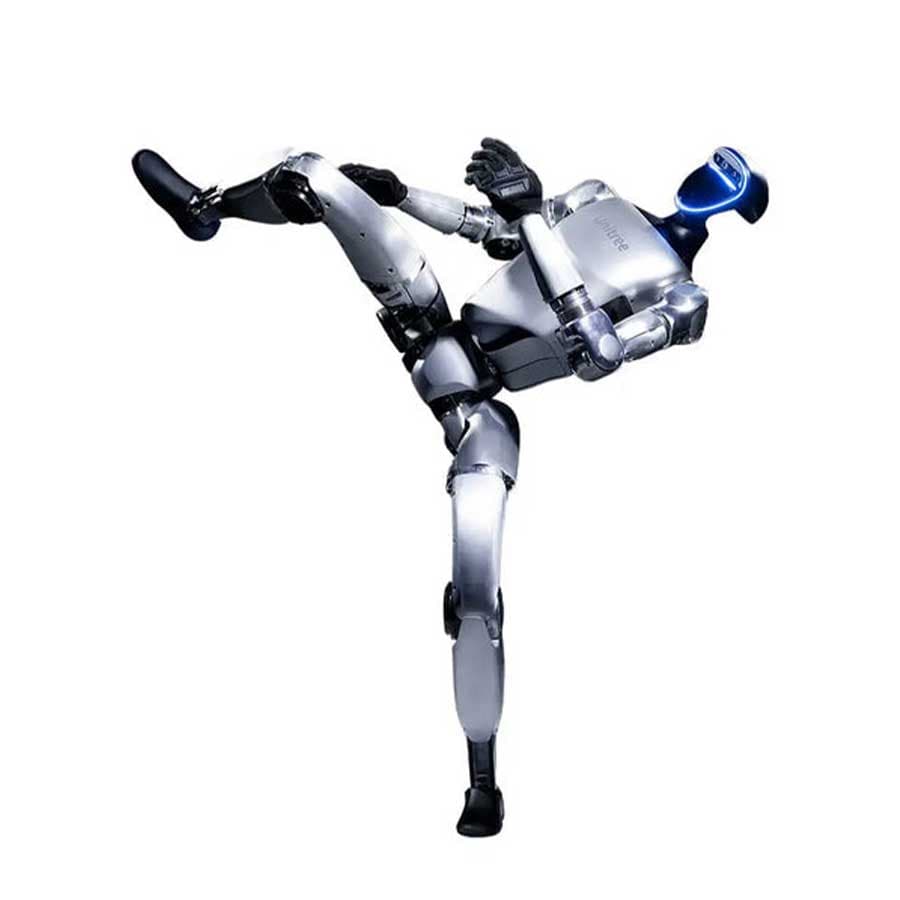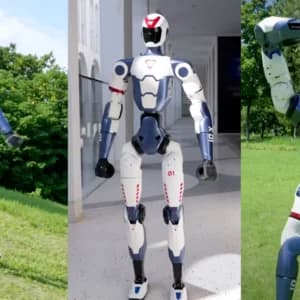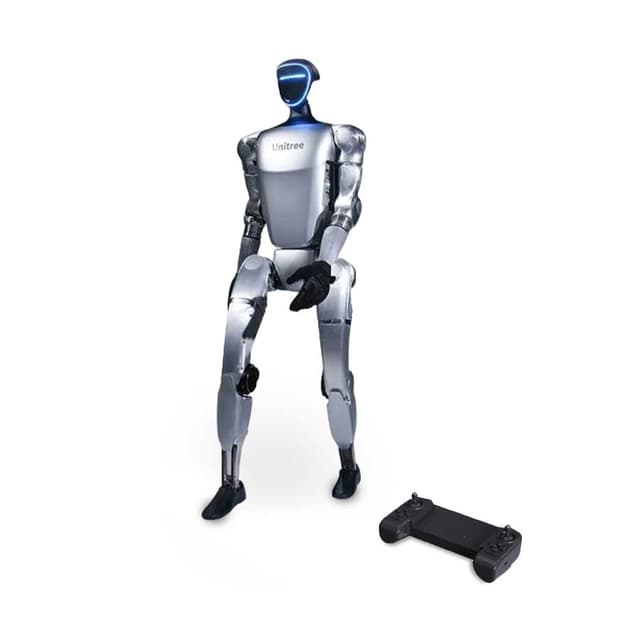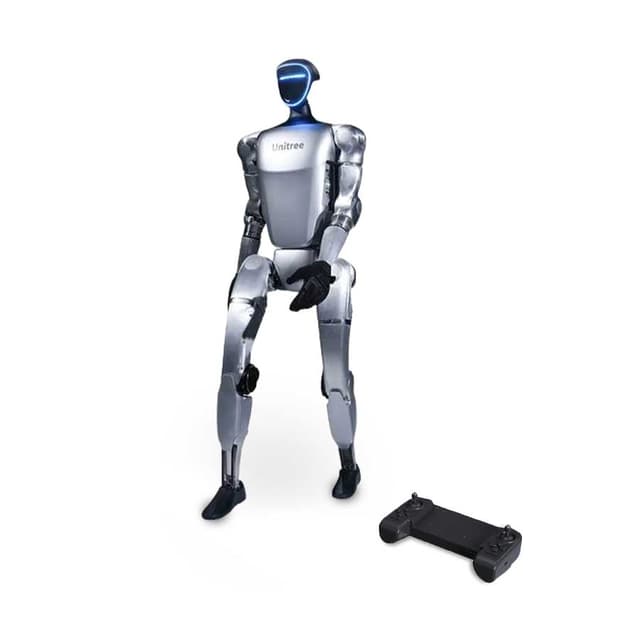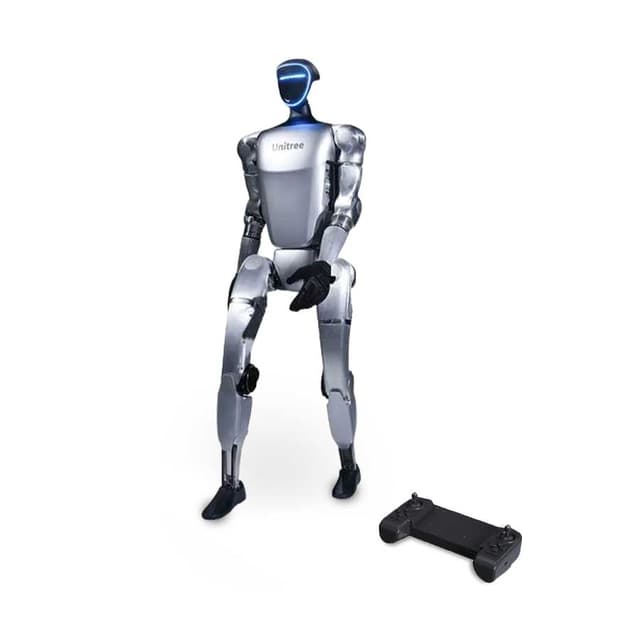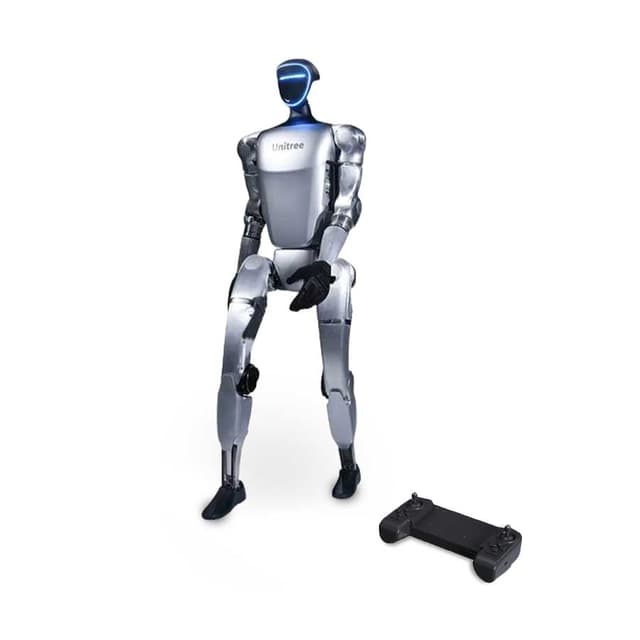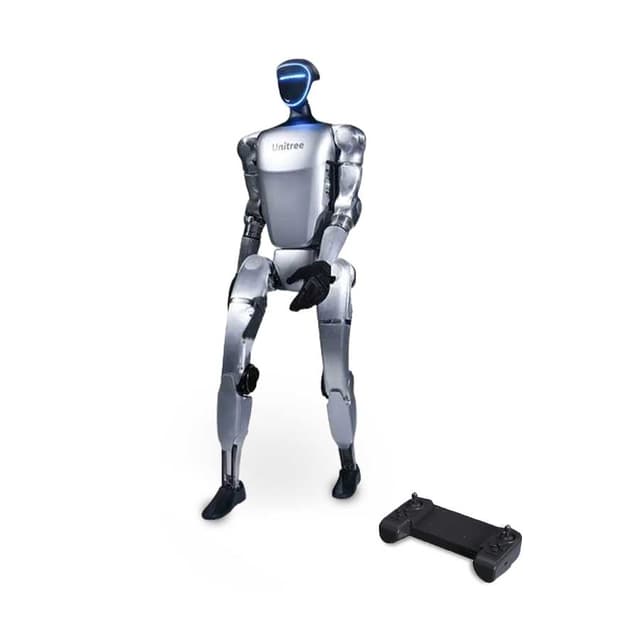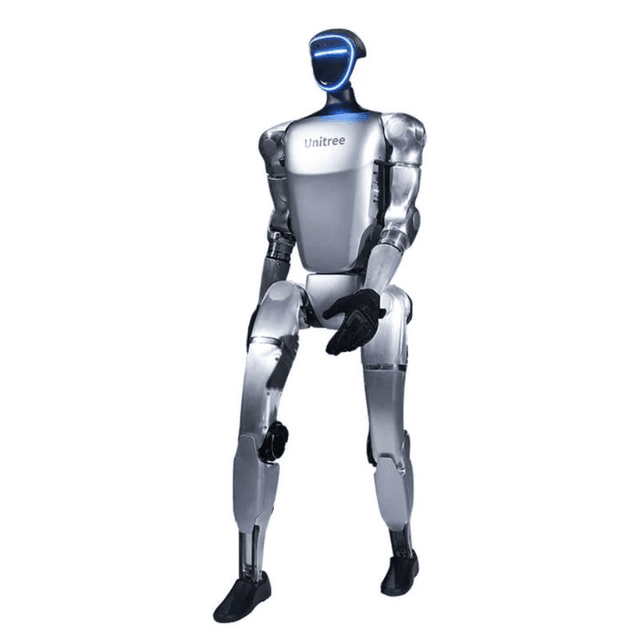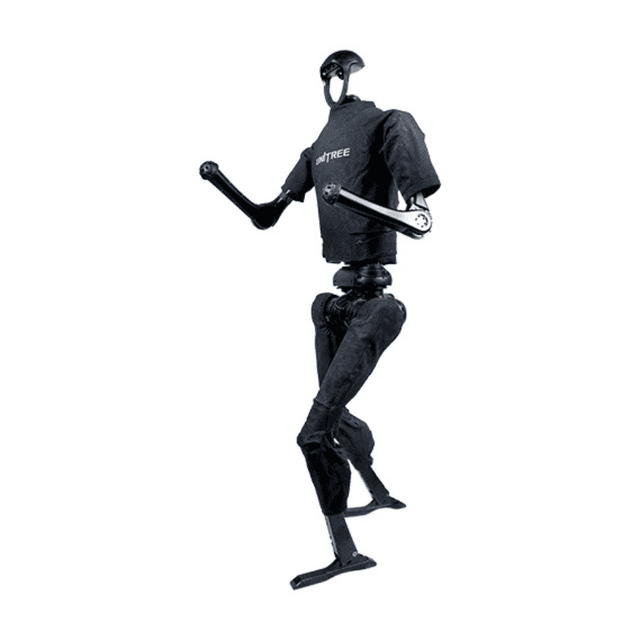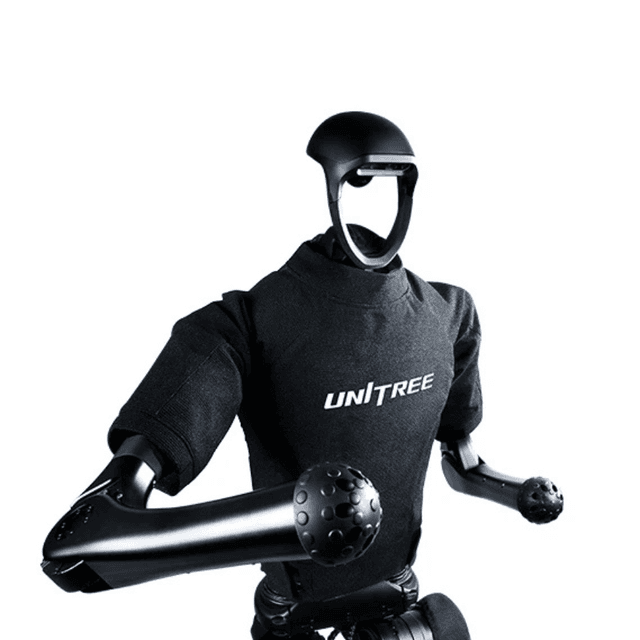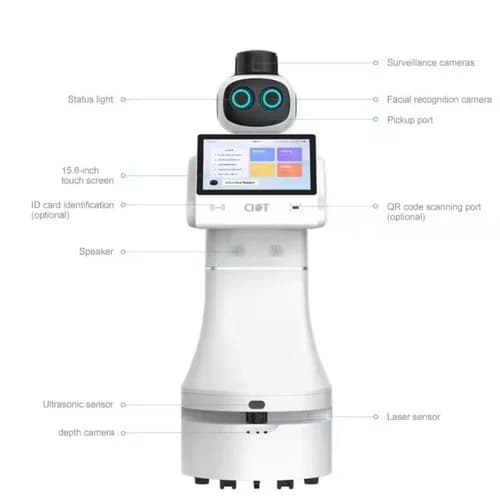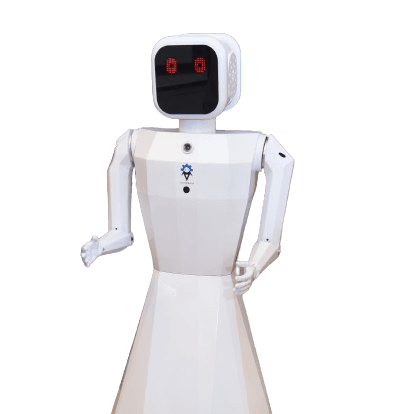Unitree G1 Edu-U4 Humanoid Robot – Available at Everse
Explore the Unitree G1 Edu-U4 Humanoid Robot, a cutting-edge robotic platform available through Everse. Engineered by Unitree, the G1 Edu-U4 combines advanced AI, exceptional mobility, and precise manipulation, making it an ideal solution for researchers, educators, and innovators in robotics, healthcare, and entertainment.
Realistic Motion and High-Degree Articulation
The Unitree G1 Edu-U4 achieves exceptional mobility through a precisely engineered skeletal system featuring between 23 and 43 joint motors, supporting an impressive 43 degrees of freedom (DOF). This extensive joint configuration includes enhanced waist flexibility with 3 DOF and highly articulated arms with 7 DOF each, allowing the robot to perform a wide range of human-like movements. Its biomechanics enable it to walk, turn, crouch, gesture, and balance with lifelike smoothness, making it highly suitable for real-world navigation and interaction scenarios. Weighing approximately 35 kg and standing ~132 cm tall, the G1 Edu-U4 maintains a human-scale form factor, which enhances its usability in environments designed for people. The mobility system is reinforced by a robust structural frame made of lightweight alloy and composite materials, enabling agile movement without compromising durability. A powerful 120N·m torque at the knee joint ensures that the robot can perform dynamic lower-body motions, such as lifting light payloads, maintaining stable postures, or navigating obstacles. Whether performing routine walking sequences or executing more complex movements in an interactive or experimental setting, the Edu-U4 delivers precision and realism. These capabilities support research in gait optimization, rehabilitation robotics, and advanced locomotion algorithms, allowing researchers and developers to explore the next frontier in human-robot interaction and mobility simulation.
Force-Controlled Dexterity for Delicate Manipulation
At the heart of the Unitree G1 Edu-U4’s manipulation capability are its two Dex3-1 dexterous hands, each equipped with three independently controlled fingers and tactile sensors. These hands use a force-position hybrid control approach that enables the robot to grasp, hold, and manipulate objects with sensitivity and precision. Unlike conventional grippers, the three-finger configuration allows for adaptive handling of various shapes and materials, closely mimicking how a human might use fingertips and grip variation to manage different objects. This makes the robot particularly effective in delicate tasks such as picking up fragile items, positioning tools, or interacting with objects that require subtle pressure control. The integrated tactile sensors provide real-time feedback on contact force and surface interaction, allowing the robot to adjust its grip dynamically to avoid slipping or applying excessive force. This level of manipulation is valuable in settings like surgical simulation, laboratory automation, or assistive care, where the accuracy of motion and force control are paramount. Additionally, the coordinated operation of both arms enables bimanual tasks—such as opening containers, performing symmetrical gestures, or manipulating two objects simultaneously—making the G1 Edu-U4 a powerful research platform for studies in dual-arm coordination, object recognition through touch, and adaptive manipulation strategies. Overall, these hands enable functional, expressive, and precise interactions, pushing robotic manipulation capabilities closer to the human standard.
Adaptive Intelligence and Onboard Learning
The Unitree G1 Edu-U4 is equipped with UnifoLM (Unitree Robot Unified Large Model), an advanced AI framework that supports imitation learning, reinforcement learning, and multimodal interaction. This AI architecture enables the robot to perform context-aware decision-making, recognize patterns, and improve its behavior over time. With imitation learning, the G1 Edu-U4 can observe human actions and replicate them, allowing for intuitive programming through demonstration—a significant advantage in collaborative robotics and training environments. Reinforcement learning further empowers the robot to self-optimize by analyzing outcomes from past interactions and adjusting its behavior to improve task efficiency and safety. This learning loop makes the robot suitable for evolving environments and open-ended research experiments where adaptability is essential. The AI’s performance is underpinned by a 100Tops computing platform integrated into the robot's expansion dock, which allows real-time processing of complex sensor data, including vision, voice, and tactile feedback. The Edu-U4’s natural language processing engine supports voice commands, enabling intuitive human-robot communication, while its image recognition systems detect faces, objects, and environmental features for more responsive engagement. These capabilities allow the robot to function autonomously or as an intelligent assistant across a variety of domains, from education and healthcare to service robotics. Its cognitive flexibility and embedded AI tools make it not only a capable machine but also an active learning agent—ideal for experimentation in behavioral robotics, human-machine interaction, and AI-in-the-loop development.
Comprehensive Development Environment and Hardware Support
Designed for open innovation, the Unitree G1 Edu-U4 offers a development ecosystem that supports full software and hardware customization. It comes with an open SDK, robust APIs, and thorough documentation, enabling developers to program everything from low-level motor control to high-level decision-making algorithms. This level of access makes it a valuable platform for robotics engineers, computer scientists, and students working on AI, control systems, or human-robot interaction projects. The 100Tops processing dock also allows the execution of high-complexity models on-device, which is crucial for latency-sensitive tasks such as real-time vision processing or adaptive motion planning. Developers can access real-time data streams from tactile sensors, joint encoders, and depth cameras, which are vital for building closed-loop control systems and conducting machine learning experiments. The modularity of the platform allows users to expand or reconfigure the robot’s sensor suite, integrate third-party hardware, or build custom attachments for specific applications. The Edu-U4 supports integration with popular development environments and simulation tools, including ROS (Robot Operating System), enabling easy prototyping, testing, and transition from virtual models to real-world execution. This development flexibility makes the robot an ideal testbed for exploring novel algorithms in path planning, collaborative AI, gesture recognition, or robotic perception. Whether in an academic research lab or an advanced prototyping facility, the G1 Edu-U4 provides a deeply programmable, extensible platform for accelerating the development and testing of future-forward robotic technologies.
Integrated Power, Connectivity, and Operational Reliability
The Unitree G1 Edu-U4 is built to function reliably in diverse environments thanks to its self-contained power and connectivity systems. Its rechargeable lithium-ion battery provides between one and two hours of runtime, depending on usage intensity, and is supported by a fast-charging system that enables quick redeployment. The inclusion of a localized air-cooling system ensures thermal stability during high-performance tasks, safeguarding the internal electronics and processors during continuous operation. On the connectivity side, the Edu-U4 features both Wi-Fi and Bluetooth interfaces, making it easy to network with other systems, stream data, receive firmware updates, or remotely control the robot in live environments. These connectivity options allow the robot to be integrated into larger Internet of Things (IoT) infrastructures, classroom networks, or cloud platforms for extended computing and storage. The onboard depth cameras and tactile sensor arrays give the robot the ability to navigate and interact with its surroundings autonomously, enhancing its suitability for tasks in unpredictable or human-centric environments. The seamless combination of mobility, sensing, AI processing, and communications allows the G1 Edu-U4 to perform consistently in scenarios ranging from collaborative learning and training to interactive exhibitions and hazard-prone inspections. Whether operated in standalone mode or as part of a larger robotic system, the Edu-U4 offers dependable uptime, robust real-time data handling, and efficient energy use, making it a practical and intelligent solution for both short-term experiments and long-term deployments.
Key Features
- Exceptional Mobility – With 23 to 43 joint motors and 43 degrees of freedom (DOF), including upgraded waist (3 DOF) and arm (7 DOF per arm) articulation, the G1 Edu-U4 delivers fluid, human-like movements for complex environments.
- Precision Manipulation – Equipped with two Dex3-1 force-controlled three-finger dexterous hands with tactile sensors, the G1 Edu-U4 enables sensitive, accurate object handling via force-position hybrid control.
- Advanced AI Technology – Powered by UnifoLM (Unitree Robot Unified Large Model), the G1 Edu-U4 supports imitation and reinforcement learning, fostering intelligent decision-making and seamless human-robot collaboration.
- Developer-Friendly Platform – Features a built-in expansion dock with 100Tops computing power, supporting high- and low-level secondary development with AI algorithms, comprehensive manuals, and technical support.
- Seamless Connectivity – Wi-Fi and Bluetooth ensure effortless integration with external systems, enhancing versatility for research and prototyping.
- Reliable Power System – A rechargeable lithium-ion battery provides 1–2 hours of runtime, supported by a fast-charging system to minimize downtime.
Applications
The Unitree G1 Edu-U4 excels in a variety of innovative settings –
- Research & Development – Its flexible structure and advanced joint configurations make it a premier platform for studying locomotion, manipulation, and AI-driven robotics.
- Healthcare Assistance – With precise dexterous hands, the G1 Edu-U4 handles delicate medical tools or supports rehabilitation tasks, showing promise for surgical and therapeutic applications.
- Hazardous Environments – Its remote-control capabilities and robust design enable safe inspections and material handling in disaster zones or nuclear facilities.
- Entertainment & Performance – The G1 Edu-U4’s lifelike movements captivate audiences in interactive performances or theme park installations.
- Education & Training – An exceptional tool for teaching robotics, AI, and engineering, its programmable features support hands-on learning in academic settings.
Unitree G1 Edu-U4 in the Lineup
The G1 Edu-U4 builds on the core capabilities of the standard G1 model, with enhancements like 43 DOF, a 120N·m knee joint torque, and three-finger dexterous hands. Compared to the heavier, industrial-grade H1, the G1 Edu-U4 prioritizes flexibility and customization for research and education, offering an accessible entry into advanced humanoid robotics.
Technical Specifications
- Height – ~132 cm (estimated, based on human-scale design)
- Weight – ~35 kg (77 lb, based on G1 series specifications)
- Degrees of Freedom (DOF) – 43 joints (3 waist, 7 per arm, plus dexterous hands)
- Joint Motors – 23–43 motors for enhanced agility
- Material – Lightweight alloy and composite frame
- Mobility – Advanced movements including walking, running, and complex gestures
- Knee Joint Torque – Maximum 120N·m
- Arm Load Capacity – Maximum 3 kg
- Dexterous Hands – Two Dex3-1 force-controlled three-finger hands with tactile sensors
- AI – UnifoLM (Unitree Robot Unified Large Model) with imitation and reinforcement learning
- Computing Power – 100Tops via built-in expansion dock, supporting secondary development
- Sensors – Depth cameras and tactile sensor arrays for navigation and interaction
- Voice Recognition – Natural language command processing
- Image Recognition – Face and object detection
- Battery– Rechargeable lithium-ion (1–2 hours runtime)
- Charging – Fast-charging system
- Connectivity – Wi-Fi, Bluetooth
- Development Support – Open SDK, APIs, and comprehensive technical manuals for high- and low-level secondary development
- Warranty – One-year warranty for the entire machine
- Use Cases – Research, healthcare, hazardous environments, entertainment, education
Why Shop with Everse?
Everse is your trusted retailer for advanced robotics, offering the Unitree G1 Edu-U4 with exceptional customer support. Our team is dedicated to helping you select the perfect robotic solution for your research, educational, or creative projects. With Everse, you benefit from cutting-edge technology, comprehensive technical support, and a one-year warranty. Shop confidently and embrace the future of robotics.
Connect With Us
Ready to explore the Unitree G1 Edu-U4? Contact us via WhatsApp or follow us on Instagram, YouTube, and LinkedIn for updates and demonstrations.
Transform your robotics journey with the Unitree G1 Edu-U4, available now at Everse.
Specifications of Unitree G1 Edu-U4- Humanoid Robot
- Height, Width, and Thickness (Stand): 1520×450×200mm
- Height, Width, and Thickness (Fold): 690×450×200mm
- Weight (With Battery): About 35kg
- Total Degree of Freedom (Joint Freedom): G1 – 23 | G1 EDU – 23–43
- Single Leg Degrees of Freedom: 6
- Waist Degrees of Freedom: G1 – 1 | G1 EDU – 1 + (Optional 2 additional)
- Single Arm Degrees of Freedom: G1 – 5 | G1 EDU – 6
- Single Hand Degrees of Freedom: G1 – / | G1 EDU – 7 (Optional, Force-controlled three-fingered hand)
- Dexterous Hand (Dex3):
- Thumb: 4 active degrees of freedom
- Index finger: 2 active degrees
- Middle finger: 5 active degrees
- Optional tactile sensor array installation
- 2 optional additional wrist degrees of freedom
- Joint Output Bearing: Industrial grade crossed roller bearings (high precision, high load capacity)
- Joint Motor: Low inertia high-speed internal rotor PMSM (better response speed and heat dissipation)
- Maximum Torque of Knee Joint: G1 – 90N·m | G1 EDU – 120N·m
- Arm Maximum Load: G1 – About 2kg | G1 EDU – About 3kg
- Calf + Thigh Length: 0.84m
- Arm Span: About 0.45m
- Extra Large Joint Movement Space:
- G1:
- Waist joint: ±115°
- Knee joint: ±90°
- Hip joints: Pitch = ±15°, Roll = ±90°, Yaw = ±180°
- G1 EDU:
- Waist joint: Z = ±115°, X = ±45°, Y = ±30°
- Knee joint: ±90°
- Hip joints: Pitch = ±45°, Roll = ±170°, Yaw = ±180°
- Wrist joint: Roll = ±90°, Yaw = ±90°
- G1:
- Full Joint Hollow Electrical Routing: G1 – YES | G1 EDU – YES
- Joint Encoder: G1 – Dual encoder | G1 EDU – Dual encoder
- Cooling System: G1 – Local air cooling | G1 EDU – Local air cooling
- Power Supply: G1 – 13-string lithium battery | G1 EDU – 13-string lithium battery
- Basic Computing Power: G1 – 9-core high-performance CPU | G1 EDU – 8-core high-performance CPU
- Sensing Sensor: G1 – Depth Camera + 3D LiDAR | G1 EDU – Depth Camera + 3D LiDAR
- 4 Microphone Array: G1 – YES | G1 EDU – YES
- 5W Speaker: G1 – YES | G1 EDU – YES
- WiFi 6, Bluetooth 5.2: G1 – YES | G1 EDU – YES
- High Computing Power Module: G1 – / | G1 EDU – NVIDIA Jetson Orin
- Smart Battery (Quick Release): G1 – 9000mAh | G1 EDU – 9000mAh
- Charger: G1 – 54V 5A | G1 EDU – 54V 5A
- Manual Controller: G1 – YES | G1 EDU – YES
- Battery Life: G1 – About 2h | G1 EDU – About 2h
- Upgraded Intelligent OTA: G1 – YES | G1 EDU – YES
- Secondary Development: G1 – YES | G1 EDU – YES

